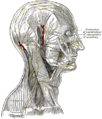Head

A head is the cephalic part of an organism, which usually comprises the eyes, ears, nose and mouth, each of which aid in various sensory functions, such as sight, hearing, smell, and taste. Some very simple animals may not have a head, but many bilaterally symmetric forms do. Heads develop in animals by an evolutionary trend known as cephalization. In bilaterally symmetrical animals, nerve tissues concentrate at the anterior region, forming structures responsible for information processing. Through biological evolution, sense organs and feeding structures also concentrate into the interior region; these collectively form the head.
Arthropods
Insects
A typical insect head possesses a pair of antennae; eyes; mandibles, labrum, maxillae and labium (the latter four forming the cluster of "mouth parts"). Lying above the oesophagus is the brain or supraesophageal ganglion, divided into three pairs of ganglia: the protocerebrum, deutocerebrum and tritocerebrum from front to back.
Vertebrates

Human head
In human anatomy, the head is the uppermost portion of the human body. It includes (from superficial to deep) the scalp and face, the skull, the sinuses and the brain.
Use in heraldry
Both human and animal heads frequently occur as immobile charges in heraldry. The blazon, or heraldic description, usually states whether an animal's head is couped (as if cut off cleanly at the neck), erased (as if forcibly ripped from the body), or cabossed (turned affronté without any of the neck showing). Human heads are often described in much greater detail, though some of these are identified by name with little or no further description.
Gallery
-
Mid-sagittal section of a human skull, by Leonardo da Vinci, c. 1489
-
Transection of a human head, by Thomas Bartholin, 1673
-
Nerves of the human head, from Gray's Anatomy, 1858
-
Muscles of a horse's head, from Traité d'anatomie comparée des animaux domestiques by Auguste Chauveau, 1890
-
Head of St. John the Baptist by Andrea Vaccaro, oil on canvas, 17th century
-
Sculpture of the beheaded Sainte Solange, patron saint of the French province of Berry
-
Patron saints of Zürich, fresco, c. 1400-1425
-
Heraldic depiction of a bison head cabossed








